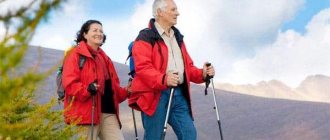Squats are one of the few effective exercises for working almost every major muscle group, including the quadriceps, hamstrings, glutes, back and calves, when done correctly.
Learning proper squat technique comes down to ingraining a few simple skills and following a few effective tips (which you'll learn next).
The back squat is the most widely used and highly prized form, but variations such as front squats, goblet squats, and Bulgarian split squats can be equally effective.
According to bodybuilding theorists, if you don't squat, you're making a big mistake.
Of course, you can tone your legs without squatting (there are many other exercises you can do to train your quads, hamstrings, glutes, and calves), but the reason the barbell squat is the sole leader is because it is the most hard exercise.
It requires almost every major muscle group in your body to work together (coordinated) to create enormous force, as well as near-perfect form if you're ever going to squat any significant weight.
You can cheat on the bench press and even the deadlift and end up lifting heavy weights, just not on the squat.
If you do not have sufficient strength and technique, you will not succeed in this exercise.
It's also one of the best compound exercises for developing every major muscle group in your body, from tip to toe.
By the end of the article, you'll learn how to squat with near-perfect form, the best variations, 12 ways to improve your classic squat, and a simple but hard, effective workout to boot.
What muscles work when squatting?
The squat is a unique exercise that works almost every major muscle group, including the arms, chest, and shoulders.
In particular, it helps you develop:
- quadriceps femoris muscle (quadriceps);
- gluteal muscles;
- hip flexor and extensor muscles;
- latissimus dorsi muscle;
- trapezoid;
- calf muscles.

As you probably know, most muscles in the body have antagonists - muscles that are opposite in action, that is, when the muscle is active, the opposite one relaxes.
For example, when you curl a barbell with your biceps, your triceps are relatively inactive. And when pressing with a narrow grip, the triceps work, but the biceps are practically not.
The quadriceps and hamstrings have a similar relationship, but thanks to a quirk of human anatomy called Lombard's Paradox, the squat is able to engage both of these muscles at the same time. This is one of the reasons they are so effective (and complex).
Barbell squat technique
Squats are the most useful and effective for gaining muscle mass and strength, but at the same time they require good technique, otherwise they can become dangerous.
So let's figure out how to squat step by step.
Let's look at the three steps to proper squat form, starting with preparation.
Preparation
Proper preparation comes down to several points:
Set the height on the frame (stand); Place the bar on the frame; Grab the bar; Remove the projectile from the rack; Positioning the legs.
Let's take a closer look at each of these points.
Rack height
First of all, make sure that the stand is not too high or too low.
You should be able to remove the bar without sitting under it or standing up on your toes.
This is approximately 3-5 cm below the final height of the bar when you stand up, or approximately at the top of the sternum.
Experiment with an empty bar to determine the height you need.
There are two ways:
- High position;
- Low position.
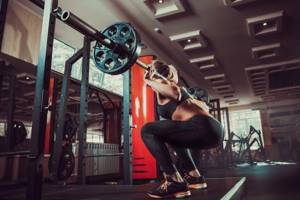
squats high low Both methods have pros and cons, but the differences are minor and ultimately you should do what works best for you.
Low position. In a low squat, the bar is positioned in the middle of the trapezius and rear delts, as in the picture above.
The benefits of this method are that it allows you to lift a little more weight, it engages more of your hamstrings, and it generally feels safer. Therefore, many people (new to the gym) prefer this method.
The downside is that it doesn't allow you to squat as deep as a high barbell position, and this can cause shoulder pain, especially if you squat several times a week.
High position. The bar is located at the top of the trapezoid, as in the picture above.
The benefits are that it allows you to reach more depth, it puts a bit of stress on the quads, and it doesn't impact the shoulders as much.
This is why advanced powerlifters and weightlifters train high and squat low in competition to lift maximum weight.
The disadvantages are that most people cannot squat heavy weights with a high barbell position, it requires more developed upper back muscles, and the technique is more difficult for beginners.
So which one should you choose?
It mostly comes down to personal preference.
You need to choose any one that is more convenient for you. For most people this will be a low position, at least at first, but try both and decide for yourself.
One thing to remember:
When you squat with a high barbell position, make sure the bar is on your trapezius and not on your spine. This is a common mistake, especially for people with small traps, and is the main reason why people feel the need to use pads (wrapping a towel around the bar).
A thumbless grip allows you to keep your wrists straight, especially when doing low squats. A full grip makes it easier to control the barbell and allows you to keep your hands closer together.
So which one should you choose? Use whichever one feels more comfortable.
Whichever you choose, try to grab the barbell as close to your shoulders as possible.
Some people also say that the wrists should only be straight, but this is not necessary. In any case, the weight of the barbell falls almost entirely on your back. Therefore, if you slightly change the position of your wrists to make it more comfortable, this is absolutely normal.
Barbell squats - technique, features, common mistakes
Objectively speaking, there is perhaps no more important exercise in bodybuilding than the squat. Squats involve almost all the muscles of the body, causing an unprecedented increase in strength and mass. This is why squats are called the king of exercises. However, in bodybuilding there is still debate about whether squats are necessary. Opponents of the king of exercises scream that squats are incredibly dangerous, and besides, they spoil the proportions of the body (allegedly they make the waist thicker and the buttocks larger). Today we will try to debunk this myth and teach you how to squat correctly.
Classic squats with a barbell on the shoulders are a basic exercise that involves almost all the muscles of the body, causing an unprecedented increase in strength and mass, but the main load falls on the quadriceps, hamstrings, gluteal muscles, and the muscles of the lower back. This is why squats are called the king of exercises.
Difficulty: medium
To perform the exercise you will need the following equipment:
- Power frame or barbell racks;
- barbell with a straight bar.
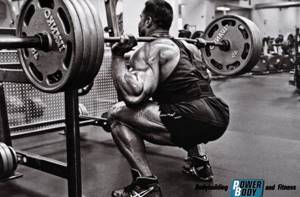
Squat technique:
- This exercise is best performed in a power rack for safety reasons. To begin, place the bar on a rack just above shoulder level. Once the correct height is selected and the bar is installed, step under the bar of the bar and place it on your trapezius muscles (on your back just below your neck).
- Hold the barbell using both hands with a wide grip and lift it off the racks, pushing with your legs first and at the same time keeping your back tight and your lower back arched.
- Step away from the racks and place your feet shoulder-width apart in a middle position, toes slightly pointed out. Keep your head straight or slightly up at all times and maintain a straight back, bringing your shoulder blades together. This is your starting position. ( Note: For the purposes of this article, we will use the middle position described above, which equally targets overall development, however you may choose other positions and shift the load, such as the hip adductors and glutes).
- Begin to lower yourself slowly by bending your knees. Watch your hips, maintain a straight back at all times with your head slightly raised up. Continue squatting down until your thighs touch your shins. This part of the exercise is performed while inhaling. Move your pelvis back as you move down. Try not to let your knees go forward beyond your toes when performing the exercise, so as not to create dangerous tension in the knee joints, which can lead to injury. Also, do not straighten your knees completely when standing up, so as not to overload your joints.
- As you exhale, begin to rise with the barbell, placing your feet on the floor mainly on the heels of your feet, straighten your legs and return to the starting position.
- Repeat these steps for the recommended number of repetitions.
This type of squat allows for a greater range of motion and allows the torso to maintain a more upright position than other types of squats due to the position of the foot and the higher position of the barbell.
Tips for implementation:
- Don't round your back.
- Do not lift your heels off the floor, do not bring your knees together. Try not to let your knees extend past your toes, as this can put dangerous stress on your knee joints.
- Keep your head straight, don't lower it down. The back is straight throughout the entire exercise.
- Do not place the barbell directly on your neck.
Common Mistakes
The squat is a technically difficult exercise, in which athletes often make many mistakes. The main and most common of them are to perform squats with insufficient amplitude (that is, not even up to parallel with the floor). This depends on the following reasons:
- Insufficient spread of the feet to the sides, which may cause the knees to roll inward.
- The lower back is not arched enough. As a result, this leads to an even greater curvature of the back, which occurs during the initial stage of movement:
- The elbows are not brought forward properly, while the back is not arched in the lower back and thoracic region. As a result, the bar is not in the required (low) position and the most effective lever system from an anatomical point of view is not provided.
Execution options:
- When the feet are placed narrowly, the load shifts slightly to the outer part of the thigh muscles (lateral head of the quadriceps);
- When the legs are positioned wide, the load falls more on the inner thighs and gluteal muscles;
- If you want to maximally load the muscles of your thighs and buttocks, perform squats through a full range of motion.
- Front squats allow you to focus on all four heads of your quadriceps. The technique for performing such squats is more complex, so the weight of the barbell should be significantly less.
Myths about the dangers of squats
Squats are believed to make your butt bigger. The glutes are actually heavily involved in the squat, and if you squat deep enough, they take on a significant portion of the load. I'm not even going to argue with this. The moot point is different; who said that the gluteal muscles do not need to be developed in the same way as all the other muscles that make up the lower body? To suggest that overdeveloped buttocks can disrupt the proportions of the lower body is, at the very least, ridiculous. Take a look at the photos of bodybuilding legends: John Grimek, Sergio Oliva, Arnold Schwarzenegger - they all had well-developed buttocks, but this did not spoil their appearance. Yes, yes, and these guys’ waists were always in perfect order!
And mind you, they were all doing deep squats with heavy weights. Oliva and Grimek were both competitive weightlifters in their day, for whom squats are an integral part of their training. As for Arnold, he often went out of town with friends, loading a barbell into the trunk of the car, and there the guys did nothing but squats all day.
All great athletes squatted because they knew that squats build a strength base, without which further progress is impossible. They also knew that squats not only increase the size of the lower body, but also the upper part of the body!
Remember: squats won't make your butt bigger, but they will develop your overall muscles.
Knee problems - myths and reality
In fact, when it comes to safety, squats are no different from any other exercise, be it the bench press, overhead presses or curls. If it is performed correctly, it is absolutely safe, but if the technique is used incorrectly , then problems may arise.
I don’t know whether I’ll surprise you or not, but learning to squat correctly is extremely simple, and all because this movement is absolutely natural for the human body. Give me a beginner who has never squatted in his life, and I will teach him this exercise in a couple of minutes. It may take several lessons in order to, as they say, develop the technique of doing squats, but if he has not had time to learn what is not necessary, then he will immediately begin to squat CORRECTLY.
It is not clear why many people believe that full squats are much more dangerous for the knee joints than half squats. In fact, when an athlete performs quarter- or half-amplitude squats, the knee joints, as well as the surrounding muscles, tendons and ligaments, take on all the load associated with stopping at the bottom of the movement.
For such a vulnerable ligamentous apparatus, such a load is excessive. It’s a completely different matter when the same athlete lowers the barbell below a line parallel to the floor. In this case, much more powerful muscles and ligaments take on the same load: the adductors of the hip, buttocks, hip flexors and lower back.
It is for this reason that those who think that squatting to parallel will protect their knee joints from damage are actually putting much more stress on them than if they were doing classic deep squats. The real reason athletes don't squat deeply isn't because they're afraid of hurting their knees or getting a big butt or a big waist. It's just much more difficult to squat deeply, and these guys are just lazy!
To tell the truth, I might also really like to do without squats altogether, replacing them, for example, with leg presses in the machine, because squeezing a platform with a weight of 200 kg is much easier than squatting with the same weight, but An immutable law of bodybuilding says: the less effort we put into an exercise, the less benefit it brings. Therefore, if you want squats to bring real benefits, you need to do deep, full squats, so much so that after the approach your eyes ripple! But I want to warn you: before you start doing all this, you must master the technique of doing squats perfectly.
How to squat correctly?
- First of all, you need to learn how to correctly position the barbell on your back. Often, an athlete, feeling the unpleasant pressure of the bar, tries to slip out from under it, but this only intensifies the unpleasant sensations. To relieve this pressure, lift your trapezius muscles upward. Some beginners start complaining that they don't have trapezius, but in reality this is not the case. Everyone has trapezoids, so try to use what you have.
- Hold the bar tightly so that it does not crawl on your back - a “walking” bar can cause a lot of inconvenience. As for the width of the grip, it is determined individually, but the general rule is this: the narrower the grip, the easier it is to control the bar. Try experimenting to find out what grip width is right for you. Many fitness centers often ask you to place special pads or towels under the bar.
- This is not a very good idea, since as soon as the weight of the bar becomes more or less noticeable, all this equipment will immediately begin to slide or “walk” along the back. Learn from the very beginning to feel and control the working weight on your shoulders!
- Holding the barbell firmly on your back, step back from the racks and place your feet slightly wider than your shoulder span. In this case, the socks should be slightly turned outward. This again may require some practice to figure out the best position for you. For example, very tall athletes prefer a wider stance. Whatever the stance you choose, don't ignore this important aspect of the squat. Proper foot placement will allow you to feel balanced and squat below parallel.
- Before performing your first rep, try to tense your entire body from your ankles to your shoulders. Relaxation of any part of the body will adversely affect the exercise.
- Most trainees believe that looking slightly up helps them perform squats more correctly, but some people prefer to look down. In any case, the head should not be in any extreme position.
- Now we begin to descend. Imagine the barbell as part of your body. A full squat can be considered a movement in which the upper parts of your thighs slightly cross a line mentally drawn parallel to the floor. If you have not reached this line, then you have only performed a partial squat, which is much less productive in terms of developing the hip flexors and adductors. Don't forget that full squats also engage the muscles of the buttocks and lower back.
The exercise should not be performed either quickly or slowly; the speed of movement should be constantly monitored. Squats at too fast a pace are risky in terms of breaking technique. Squats that are too slow cause the athlete to lean too far forward in the middle portion of the movement.
Pause before performing the next repetition. Often, especially with light weights, athletes tend to squat as quickly as possible, which negatively affects their technique. Please understand that absolutely EVERY repetition, even with a very light weight, must be performed as if the barbell were loaded with maximum weight. Take a breath in a fixed position when you rise from a squat. Hold your breath during the squat at least until you get past the sticking point in the ascent. It is undesirable to breathe during the exercise - it relaxes and negatively affects the technique.
When squatting, use a weightlifting belt. It is needed not so much to protect the back (as many people think), but as a sensor; The belt will always alert you if you lean too far forward or round your back during a squat. The belt also helps keep your back warm, which is extremely important.
If we talk about other equipment used in squats - like bandages and special tights - forget about them. They are useful for powerlifters who are interested in squatting as much weight as possible rather than maximizing muscle development. All this is not suitable for bodybuilders - at best, long-term use of the above things will lead to a disproportion in muscle development.
Most common mistakes
Some people cannot perform a squat without lifting their heels off the floor.
This is an indicator of stiffness in the back of the foot. In addition, it has been noted that squats with heels lifted create a greater load on the knees. This goes away over time as squats themselves develop this flexibility. Wider foot placement can also help here. If the problem is more serious, you can try placing a small barbell disc or block under your heels, but try to get rid of them once you develop flexibility.
Squats with a rounded back, especially at the bottom.
This is also a common mistake. And if it is not corrected in time, problems may arise. Most practitioners believe that the most vulnerable place when squatting is the knees, but in fact it is the lower back. As a rule, the lower back is rounded because it is weak, so it makes sense to focus on the back extensors. For this purpose, it is recommended to perform barbell rows from the floor with straight legs, hyperextensions and forward bends with a barbell on your shoulders. However, as your squat performance increases, your lower back also becomes stronger.
“Punching” at the bottom of the squat.
You quickly lower yourself down with a barbell on your shoulders and spring at the bottom point in order to give yourself acceleration due to inertia when lifting. This technique can damage your joints. Stop at the bottom point and only then use muscle effort to rise up. The hip adductors can also be a problem area when squatting. The fact is that it is quite difficult to develop the strength of these muscles, and therefore they are often the first to leave the game. This is especially true if you squat with your toes turned inward - this will leave your adductors weak and weaker than your quadriceps and abductors.
If you don't take time to strengthen these muscles, problems may arise, especially with your knees. Since the adductor muscles are stabilizers of the knee joints, a special trainer for the adductor muscles works them well. Wide-footed squats can also help. In this case, the exercise should be performed with light weight and a high number of repetitions. If you have balance problems, try squatting with this technique in a Smith machine or power rack.
Well, I hope you are convinced that squats are safe and necessary. Learn to squat correctly, gradually increase the working weights, train with full dedication and you will be fully rewarded!
Removing the rod from the frame
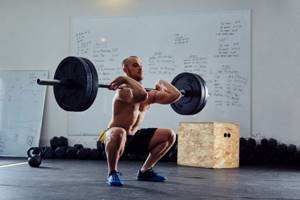
Place your feet directly under the bar (not behind), take a deep breath, grab the bar, lift your chest, and lift the bar off the rack.
Take one step back with each foot, making sure you're planted firmly on one foot before you step.
Don't take many small steps back. This wastes energy and forces you to move further, and forces you to walk a long distance at the end of the approach, which can be unsafe.
Leg position
In order to determine the ideal width of your feet, you will have to experiment. To start, position your feet slightly wider than your shoulders:
leg placement
If you want to give more load to your buttocks, then a wide position of the legs is more suitable, but not too wide (so that the execution is comfortable). Remember, you can always work your glutes with other exercises.
If you fall back while doing the exercise, try placing your feet 3-5 cm wider. If you feel tension and compression in your hips in the lower position, try placing your feet 3-5 cm wider.
It is important to pay attention to several points:
- The bar should move in a straight line up and down (not lean back and forth).
- The back remains straight (do not bend).
- Knees point towards the big toes.
- Elbows remain in place.
- The head is in line with the back.
{banner_st-d-2} Now in more detail:
First, take a deep breath, drawing air into your stomach. When you inhale, you should feel your belly expanding, not your chest.
Then press your tongue into the upper palate to close the trachea. Tighten your torso muscles as if preparing for a punch to the stomach.
Squeeze the bar as tightly as possible, open your chest and squat down, keeping your knees in line with your feet and leaning slightly forward.
In this case, you need to make sure that your knees do not converge with each other.
To avoid this during squats, think about the fact that you are pushing the floor apart with your feet.
Let's look at one of the most controversial issues in squats:
How deep do you squat?
There is a short answer to this: below the “parallel”.
This means that the hip joint is below the top of your knees, and the femur bone is parallel to the ground (or slightly below), like this: below parallel.
Anyone who's spent any time in the gym knows that most people don't get anywhere close to parallel during squats, meaning the most beneficial part of the exercise is lost.
Because the deeper you squat, the:
- greater strength and muscle mass as a result;
- the buttocks are better developed;
- the hips take the pressure off your knees;
- The lower back becomes stronger.

So, it's pretty clear that quarter and half squats are inferior in every way. And including them in numerous training programs without the correct technique is of little use.
Does this mean you should touch the ground with your buttocks? Not necessary. The full squat requires more joint mobility than most people, and it can be especially difficult for people with long thighs or torsos. However, if you can squat fully, it can provide additional strength and muscle building benefits.
What if you can’t even squat down to parallel?
Do not worry. Do your best to achieve parallel every time you squat, work on improving your joint mobility and it will come over time.
Climb
You have to focus on one word: tension.
One of the most common mistakes people make while lifting is relaxing a part of their body (upper back, abs, or grip of the bar).
You are only as strong as your weakest link. When one part of the body stops working at its full capacity, it becomes more difficult to complete the exercise.
For example, if you relax your upper back and chest halfway through a heavy rep, you will lose speed and likely end up leaning forward. Therefore, other muscles will be forced to work even harder to align, and if they fail, the set will simply end.
That's why most tips to help you rise encourage you to stay on your toes.
For example, here are some helpful tips to keep things on your toes:
Fire upward sharply after reaching the desired squat depth.
Move during the lift as if you were trying to throw the barbell off your back. This will help speed up the rise.
Imagine that you are pushing the floor apart with your legs. Guide your hips under the bar.
You may have noticed that there is a point just above parallel where, as you lift, the weight suddenly becomes much heavier and the speed begins to slow down. (If this makes you feel better, know that it happens to all elite powerlifters).
The keys to getting past this point are to start the lift with an explosive movement, hold air in your lungs, and drive your hips powerfully under your body.
Before we move on, let's look at a common problem people have when lifting: rounding the back.{banner_st-d-1}
How to keep your back straight
Many people have trouble keeping their back straight when lifting, and it ends up looking like this:
squat is impossible Some say that this is due to weakness of the core muscles. While this is certainly one factor, there are more reasons than meets the eye.
One of the main reasons is that they lift the buttocks faster than the chest.
Why is this happening? The main reason is that the barbell is too heavy.
There are several ways to fix this:
use lighter weights until you can complete all reps with correct form at any point in the squat;
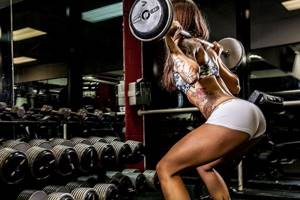
keep your back as tense as possible. Many athletes don't think about their legs while squatting. Instead, they focus on keeping their chest position the same and pressing the bar into their back as if they were trying to bend it in half.
Imagine that you are trying to throw the bar off your back and forcefully drive your hips under the bar. (This is one of the best tips for those who want to squat heavy weights with proper form).
Strengthen your quads with lots of squats and assistance exercises.
breathe correctly. Inhale enough air to fill your lungs to about 80%, and hold it for the entire repetition (one squat). Many people let air out of their lungs when they rise. And this makes it very difficult to keep your back straight and tense.
We discussed in some detail the technique of performing one of the key exercises in weightlifting, bodybuilding, and powerlifting. In the second part of this note, we will look at other types of squats and 12 ways to improve your results.
Execution technique
There are many modifications to the classic barbell squat. The technique determines which muscles work particularly intensively. However, the general principle of implementation remains unchanged. Step-by-step algorithm of actions:
- Stand straight, feet shoulder-width apart, grab a barbell.
- Move your pelvis back so that your knees and toes are strictly in line.
- Perform a deep squat. Don't be afraid of hurting your knees. On the contrary, this situation has a beneficial effect on them.
- Without lifting your heels from the floor, monitor the simultaneous movement of the shoulder and hip joints.
- Slowly straighten up, taking a deep breath.
The effectiveness of the exercise is greatly influenced by the correct breathing rhythm. He should be calm and measured. In this case, the load on the spine and working muscles will be minimal. The optimal number of squats in one approach is from 8 to 12 (for beginner athletes). An increase in this amount contributes to the formation of an important and valuable quality - strength endurance. But this needs to be done gradually. It’s better to start with an empty bar squat, then gradually add weight.
In general, when determining the optimal load, you should be guided by your well-being and common sense. If unusual symptoms appear during training (dizziness, lower back pain), you should slow down and not increase the load until the discomfort completely disappears. Discomfort occurs especially often during squats with a barbell on the back.
If everything was done correctly, after training you will feel a slight, pleasant muscle fatigue, without pain. Any discomfort indicates that gymnastics with a barbell was performed incorrectly, in violation of safety precautions.
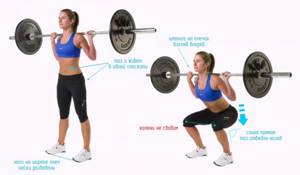
Exercise technique
Three popular squat variations
Back squats are the best leg exercise, but they are far from the only one.
Let's look at three variations that are worth knowing and that can be used instead of or in addition to the classic version with a barbell on the back:
- Frontal.
- Bulgarian split.
- Goblet squats.
- Front Squats
From the waist to the feet, they are no different from the classic ones. The key difference is that the barbell is held on the shoulders rather than on the back.
This is what it looks like:
The main advantage of front squats is that they place even more emphasis on the quadriceps and upper back and allow you to squat deeper than with the classic low bar position. In addition, they reduce the load on the knees and lower back, which makes them ideal for people who have any problems with the joints.
The disadvantage is that you cannot use heavy enough weights and this exercise is very awkward to perform.
It requires quite a bit of wrist mobility to do it correctly, so some people cross their arms like this:
This grip is more comfortable, but, unfortunately, less stable and is not suitable for working with heavy weights. This is why a traditional front squat grip is recommended, even if you can only grip the bar with one or two fingers.
Advantages and disadvantages
The barbell squat is a compound exercise. Regularly performing this type of movement has a beneficial effect on joint mobility and develops coordination. When working properly, the following muscle groups are involved:
- gluteal;
- back of the thigh;
- abdominals;
- back extensors;
- quadriceps.
This does not create additional stress on the knees, so even those who have recently been injured can include these elements in their daily exercises. Instead of a classic barbell, in such cases they take a lightweight version - a plastic stick. A strong load will not cause harm.
| Advantages | Flaws |
| Squats with a barbell have a warming effect on the muscles Helps lose weight Makes your figure fit Promotes muscle growth | Exercises must be performed frequently to achieve results. It is difficult to choose the correct weight of the barbell on your own If your workout isn't going well, you can strain your muscles. |
There are practically no contraindications. However, this type of physical activity is not recommended for those who have serious problems with the spine (for example, scoliosis). In these cases, a lighter version of the standard exercise is used, and the correct squat can only be performed under the supervision of a doctor in a physical therapy room.
Any exercises with a barbell are considered strength exercises. They are strictly forbidden to perform during pregnancy, even in the early stages.

Any exercise with a barbell is considered strength

During the barbell squat, a number of muscles are activated.

This type of exercise should be avoided by those who have serious back problems.
Work with heavy weights
What do you mean by "big"?
The “big” range usually starts at about 80 to 85% of 1RM, or a weight you can lift no more than 4-6 times per set.
What this means in practice: If you currently squat with lighter weights, such as 70-75% of your one-rep max (1RM), and do 10-12 reps, you will see a significant benefit by changing to heavier weights (80 -85% for 4-6 reps).
There is no need to completely stop training in the 10-12 rep range. But to get stronger in a shorter period of time, you need heavier weights with fewer repetitions.
Use the right equipment
Shoes should have hard soles, durable and comfortable. The best option is weight lifters.
Knee pads. Very often it is not recommended to use elastic bandages. Because they accelerate the wear and tear of the knee joints. Knee pads in this sense are the ideal solution. Unlike bandages, they give the joint stability, support, retain heat (heated tendons and ligaments stretch more easily) and do not put excessive pressure on the joint.
Weightlifting belt. Numerous sports studies show that the belt improves your performance in squats and deadlifts, but, unfortunately, does not reduce the risk of back injury. Most athletes will 100% confirm that if you use a weightlifting belt correctly, you become stronger. Your results, although not very significantly, increase.
The right attitude
Don't start the approach half asleep. You need to cheer yourself up and get started (the right choice of music can help). Another simple but effective "trick" for increasing strength is to mentally visualize successful repetitions before approaching the apparatus.
Explosive Lift
Many trainers encourage super-slow reps as the best for muscle growth and strength, but numerous experiments prove otherwise.
Much of the research has been done on the bench press because it's technically easier to do, but the squat follows the same principles.
Research shows that, for example, in the bench press, lowering the barbell quickly (1 second) and immediately explosively lifting it up without pausing results in better results than lowering it slowly and then pausing explosively.
Therefore, do not squat and rise slowly. Get down and shoot up as quickly as possible, but don't forget about safety.
Squat more often
How often you should train to gain mass is a subject of ongoing debate. One thing we know for sure: if you want to get better at something, you should do it more often.
This applies to almost everything, barbell squats are no exception. The more you squat, the better your technique will become, which will inevitably lead to faster gains in muscle mass and strength.
So if you're currently squatting once a week and your progress has stalled, adding squats two or sometimes three times a week will help you make a breakthrough. However, you should always remember that the more often you do any exercise (especially such a basic exercise as squats), the easier it is to drive yourself into a state of overtraining.
Try different types of squats
Changing exercises too often can harm your progress because you will have to learn and master new movements. In general, you need to focus your main efforts on improving fewer exercises - this will pay you more dividends over time.
At the same time, grinding the same exercises for months or years is also not very productive.
As we've learned before, different types of squats work different muscle groups, and so systematically rotating them can prevent unbalanced muscle development that can interfere with results.
For example, let's say you squatted low for a month and hit a plateau. Instead of continuing to struggle through, you can switch to front squats for 8-12 weeks to strengthen your quads and upper back. When you return to low bar squats, your results will increase significantly.
Purpose of Squats
The classic form of squats in bodybuilding is mainly aimed at training the quadriceps. Squats, of course, are heavy basic exercises; their role in muscle building cannot be overestimated. When you squat, there is practically no muscle on your body that is not working. And if you are ever asked: “What is the most important exercise for building your body?” - answer without hesitation - squats with a barbell. The main assistants in squats are the lower back muscles, and the abdominal muscles help maintain intra-abdominal pressure, while receiving a decent static load, which undoubtedly makes the abs stronger. By the way, I recommend reading the article about the rules for pumping up the abs.
Eat right
When someone complains that they are not gaining weight, size or strength, the first thing that comes to mind is that they are not eating enough. And often this is true.
If you want to gain muscle and weight as quickly as possible, you need to eat enough calories.
Let's just briefly explain that you need to have a calorie surplus per day (eat more calories than you burn).
For some very thin young men and women (ectomorphs), this is a truly difficult task. Sometimes you have to eat up to 4000-5000 kcal per day before muscle mass begins to grow.
You should always remember that increasing the number of calories you consume is a fairly easy way to increase both strength and muscle gain.
Microprogression of load
By far your number one goal is to increase your overall body strength over time.
Beginning athletes can easily achieve muscle growth without significant strength gains. But when you move to a higher level, strength and size become interdependent.
In other words, when the honeymoon period ends and your body no longer responds as strongly to training, you need to increase your strength in order to gain muscle mass.
There are no other options.
pancakes At some point you will notice that your results are no longer growing. Start adding small "micro" weights (light weights). Since adding 5 kg to the weight of the projectile, at some point it will become almost impossible.
This way you progress very slowly, but the progress does not stop.
Strengthen your quads and back
Barbell squats are one of the best ways to strengthen your quadriceps and back muscles. But over time, you will reach a point where in order to increase results, you will need to perform additional exercises to develop these muscles.
Regarding quadrats
dogs, then the best additional exercises are:
- leg press;
- leg extension in the simulator;
- lunges with dumbbells.
- For the back:
- Romanian deadlift;
- barbell pull to the belt;
- hyperextension.
Squats and age
There are a number of myths and gossip floating around bodybuilding, which you can read about here. One of the common myths is the influence of bodybuilding on the growth of a teenager. And I must admit that this myth is partly true. But it concerns not all bodybuilding, but a specific exercise that you and I are discussing today.
For boys and girls whose body has not yet completed the active phase of upward growth, it is better not to do squats with a barbell at all. It’s rude, of course, to set a conditional framework, because the growth phase is individual, but I will still take on such responsibility.
In simple terms, you don’t need to do squats if you are under 18 years old. Your body is still growing upward, and by squatting, you can stop this growth, since the load on the spinal column will not allow the spine to extend in length, and without the spine there can be no talk of any further upward growth. Don't make a gnome of yourself, allow yourself to stretch out enough.
I'm not saying that you don't need to pump your legs if you haven't changed your age. It is necessary, only with other – easier exercises. Barbell lunges, leg presses, and machine leg curls and extensions are great alternatives to squats for teenagers.
It is also undesirable for older people to squat, but if they do squat, do it with light weights and after a good, super-long warm-up before training.



